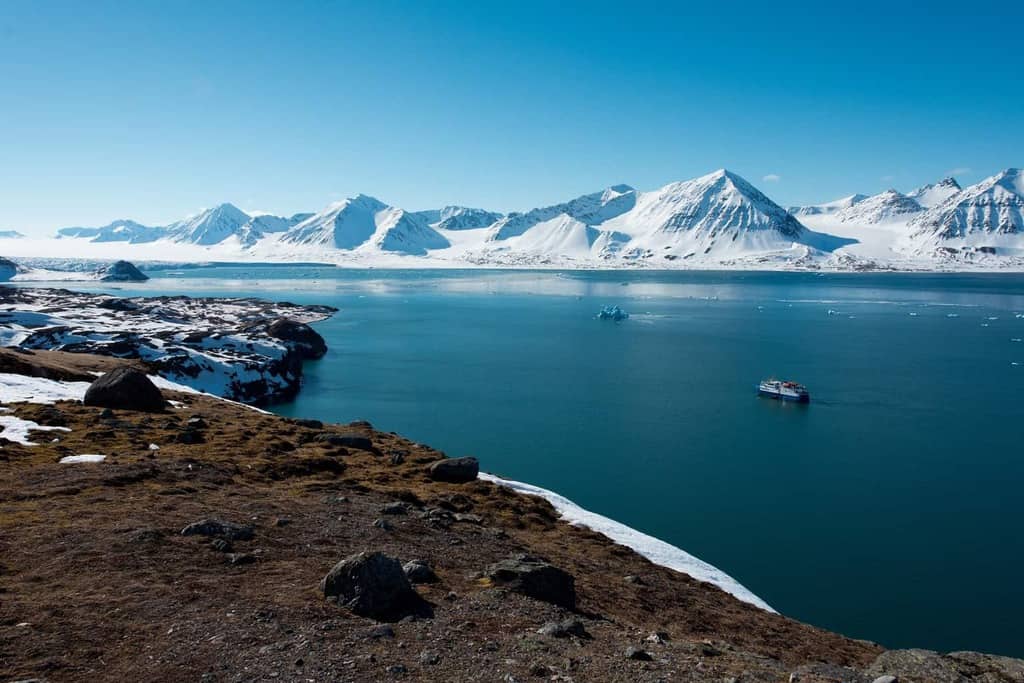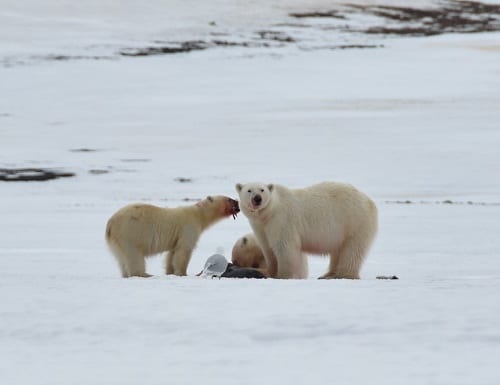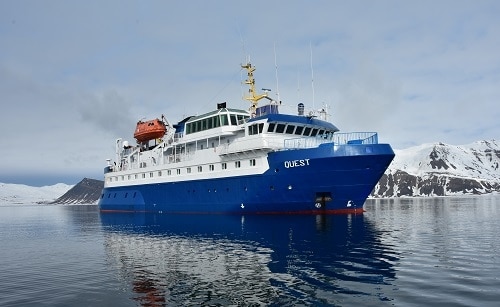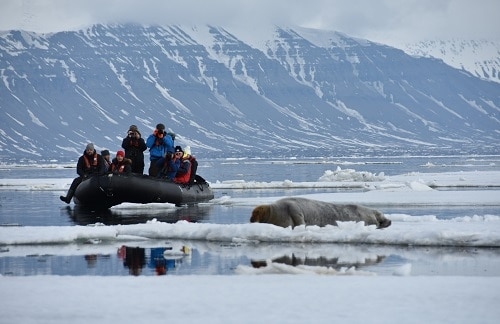Imagine an icy wonderland near the North Pole with dramatic landscapes that is home to more polar bears than humans and is easily accessible by commercial plane. This place exists and is called Svalbard. To appreciate Svalbard for all its majesty, living aboard an expedition ship capable of navigating through the ice floes in search of wildlife is a must. Picture yourself voyaging through this pristine white wilderness on a small expedition ship. You are farther north than most have ever ventured. You sail through fjords covered in ice fields. As the ship breaks through the thick ice sheets, you hear the ice crackling and the waves crashing. You stand at the bow of the boat staring upon the snow covered mountains and glaciers constantly searching and hoping for wildlife sightings. You may encounter arctic foxes, walruses, seals, beluga whales, Svalbard reindeer, Atlantic puffin, 60,000 pairs of Brünnich’s guillemots (excluding their babies) at Bird Mountain, glaucous gulls, and the highly sought after polar bears.
The midnight sun dominates the sky. You are on standby for an impromptu zodiac excursion at any time of the day or night to observe breathtaking scenery or wildlife. You are forcibly cut-off from the rest of the world as you lose internet and cell service. The only contact you have with other people are those on your ship and when your captain purposely seeks them out. You see no cars, other boats, planes, or any other remnants of civilization. It is just you and your group traveling through this enchanting untouched land. You marvel at the silence, peacefulness, and grandeur of your surroundings while sipping on a glass of wine relaxing in a panoramic lounge.
All of this and more is possible with luxurious tours offered by Polar Quest.

Where is Svalbard and How Do You Get There?
Now that you’ve decided you absolutely must experience the magic of Svalbard for yourself, where is Svalbard and how do you get there? Svalbard is a Norwegian glaciated archipelago in the Arctic Ocean between mainland Norway and the North Pole. There is no land mass between Svalbard and the North Pole, just lots and lots of ice and spectacular wildlife. A significant portion of Svalbard’s land mass consists of pack ice. The west coast of Svalbard has a mild climate, when taking into consideration its extreme northern location, and often finds itself ice free due to the Gulf Stream/North Atlantic current.
Svalbard was founded as a mining and whaling colony. It is home to an estimated 3,000 polar bears and less than 2,700 humans. The small scattered settlements are not connected by roads. You can only reach them by aircraft or boat.
To get to Svalbard, you will fly into the world’s northernmost airport servicing regular public flights: Svalbard Airport, Longyear. Longyearbyen is located on Spitsbergen, the largest island of Svalbard. The two airlines that fly to Longyearbyen are: Scandinavian Airlines (SAS); and Norwegian Airlines.

When is the best time to visit Svalbard to see Polar Bears?
Your best chance to see polar bears in Svalbard is from late May until early September. The expedition ships require enough ice to melt to be able to navigate through the icy waters.
Early in the season, the midnight sun dominates the sky and the dramatic mountain ranges are still blanketed in snow. My voyage with my husband started in late May. When we returned to Longyearbyen one week later, we were astonished at how drastically the scenery had changed. A significant amount of snow had melted, which was a sign that summer was close. If you visit in the late spring, you may see arctic foxes still sporting their winter coats as they shed their white winter coats for darker fur during the summer.
A visit later in the summer may permit farther exploration of the eastern portions of the archipelago that are blocked by ice earlier in the season. You will see more low growing purple flowers adorning the slopes. By late August, you will experience sunsets as the polar night gets closer to returning.

Why a Polar Quest Expedition Ship?
Smaller expedition ships provide a more relaxed and informal atmosphere with a significantly greater focus on the destination in comparison to those of a larger vessel. The smaller ships have the capability to navigate more freely and farther through the pack ice permitting a greater frequency of landfall excursions from zodiacs. Weather permitting, you’ll cruise on the zodiacs each day searching for wildlife and making frequent landings. In addition to wildlife encounters, you may have the chance to hike, go cod fishing, accept the polar plunge, and visit the world’s northernmost settlement.
Polar Quest offers Svalbard tour durations spanning 9-11 days aboard 3 different expedition ships: M/S Quest; M/S Stockholm; and M/S Sjøveien. The M/S Quest accommodates up to 53 passengers in 26 cabins. The M/S Stockholm and M/S Sjøveien accommodate only 12 passengers. We voyaged aboard the M/S Quest.
- Cost of the Expedition – Is the trip expensive? Is it worth it? Absolutely. No place has captured my heart the way Svalbard has. Depending on the length of the trip, the expedition ship and cabin category you select, the cost of the tour for a twin cabin will range approximately $5,300 to $11,000 per person. Nearly everything is included in the price except your flights, travel insurance, alcoholic beverages, and gratuity. The cost of the trip on the M/S Quest includes one-night hotel in Longyearbyen, accommodations aboard the ship for the remainder of the tour, zodiac excursions, an experienced expedition leader, 5 additional English speaking expedition guides, an unlimited supply of tea, coffee and water, and all meals.

- The Cabins Aboard the M/S Quest – All of the cabins on board the M/S Quest have sea-view windows (not portholes!), private bathroom facilities, a small fitted wardrobe with hangers, a hairdryer, an electrical socket, a mirror, a small safe, a desk, and chair. We chose the most economical cabin category that had two twin beds anchored against separate walls with a nightstand in the middle. The bathroom is very small and has a sink, shower, and toilet, and a quick drying floor. Our room was small, cozy, and offered unbeatable views.
- Common Areas Aboard the M/S Quest – If you aren’t on a zodiac excursion or sleeping, you will likely spend most of your time in the Panorama Lounge that offers expansive views of the dramatic untouched landscape. There are spacious observation decks surrounding the ship. The dining room on the M/S Quest is on Deck 2 where you will be treated to delicious meals in between landings. Breakfast and lunch are buffet style, and, dinner is waiter-service. The lounge includes a well-stocked bar (for additional charge) and a small library. Their wine list has something for all winetraveler lovers. They offer moderately priced wines with a nice selection from most major wine regions of the world.
Where To Stay in Oslo and Longyearbyen after the Expedition Cruise
- Oslo – We stayed at the Radisson Blu Airport Hotel in Oslo, Norway since we had an overnight layer in Oslo on our way to Longyearbyen. The hotel is connected to the airport and located immediately outside the terminals. The rooms are modern and cozy, and there’s a restaurant located in the lobby. We were served a hot dinner close to 11 pm, and were back downstairs for a hot breakfast at 5 am.
- Longyearbyen – The night before starting our expedition cruise, we stayed at the Radisson Blu Polar Hotel, Spitsbergen. It is located only 10 minutes from the Longyearbyen airport and is walking distance to the harbor, the North Pole Expedition Museum, and the Svalbard Museum. The lobby offers expansive views of the surrounding snow-capped mountains. If you have extra time in Longyearbyen, you can add activities such as dog sledding and snowmobile safaris.
Where To Eat in Longyearbyen
- Restaurant Kroa was designed to resemble a trapper’s lodge. When we visited, the tables were slabs of wood, the seats were wooden stools wrapped with leather along the top, the lantern on the table rested on a rectangular seal pelt, seal pelts lined the ceiling, and a full fox pelt hung down from the wall. The menu was a black leather binder with the cover made from seal pelt. The menu options included pizza, burgers, vegetarian burgers, and steak. For those so inclined, smoked whale was an option. You can celebrate your arrival to Longyearbyen with a Mack Beer, which is brewed from the world’s northernmost brewery located in Tromso, Norway.
Packing List
- Clothing – Being dry and warm is essential to enjoyable arctic experiences. During your zodiac excursions, your only protection from the weather elements will be what you are wearing. In cold environments, it is better to wear several layers than one thick layer. Ensure your outer layers are both water and windproof. Cotton should be avoided when planning attire appropriate for cold conditions since cotton lacks insulating properties when wet, which could be from either water or sweat.
- Outer Layers
- √ Water and Windproof Jacket
- Outer Layers
-
-
- √ Water and Windproof Pants
-
-
-
- √ Water and Windproof Gloves/Mittens – Mittens keep the hands much warmer than gloves. The inner lining should be made of synthetic fiber, silk or wool. The outer layer must be water/windproof.
- √ Warm Hat
- Inner Layers
-
-
-
- √ Warm Undergarments – Wool and synthetic fiber are appropriate undergarment materials. The inner layers closest to your skin must release perspiration and provide insulation.
-
-
-
- √ Wool or Fleece Warm Sweater
-
-
-
- √ Warm Socks (Inner and Outer Layers)
-
-
- Shoes
-
-
- √ Sturdy Knee-High Rubber Boots with Wool Insoles – The rubber boots will be a necessity for jumping off the zodiac boats for shore landings as you may often be required to get your feet wet by wading ashore. The rubber boots also protect you from the sea spray while on the zodiacs.
- √ Optional Walking Boots – The optional walking boots are dependent on whether you prefer to not walk in the rubber boots after landing.
-
-
-
- √ Regular Comfortable Shoes to wear on the ship with rubber soles to avoid slipping.
-
Winetraveler Tip: Keep the thick outer layers and boots close to the door to be grabbed at a moment’s notice as you may be called outside to observe wildlife at any time of the day or night during your expedition.
- Equipment/Supplies
-
- √ Camera – Consider upgrading your camera or renting a better camera for the trip. We took a DSLR crop frame camera with an 18-200mm lens and a tripod. We regretted not having a longer focal length lens, such as 600mm. Given the distances of some of the shots and not always being afforded the luxury of shooting from land, a faster lens would also have been beneficial.
- √ Extra memory cards for camera
- √ Extra batteries for camera
- √ Charger for batteries for camera
- √ Waterproof bags to protect cameras or other electronics while on the zodiacs
- √ Sunscreen for the limited exposed skin
- √ Seasickness Pills
- √ Any other medications
- √ Swimwear in case of opportunity to take a polar plunge. The polar plunge is where you jump off the perfectly sturdy and warm ship with a safety belt wrapped around your waist into the icy arctic waters wearing only your swimsuit. It’s invigorating!
- √ Eye mask or Black Trash Bags with Painters Tape for Sleeping – Eye masks are recommended because the midnight sun may make it difficult for you to sleep as your cabin will not get completely dark. My husband and I became experts at blackening any room after we started traveling with our babies. Covering windows with black trash bags and painters tape will blacken the brightest room. Aluminum foil also works, but it is bulkier to tote around.